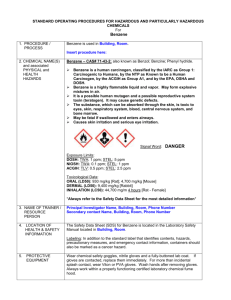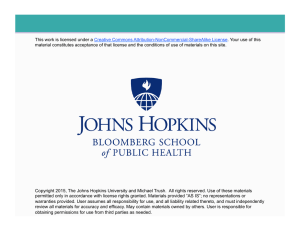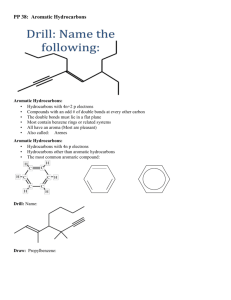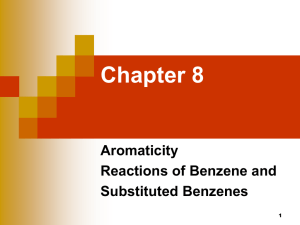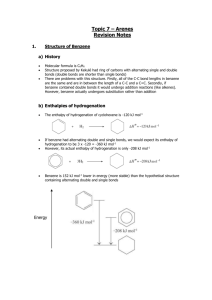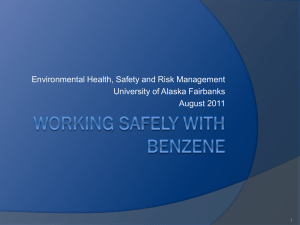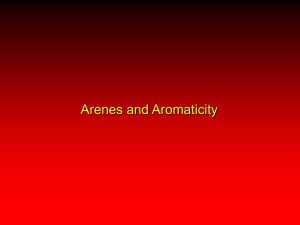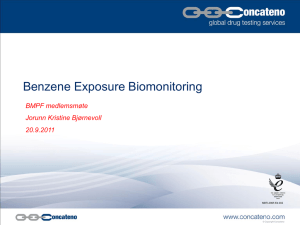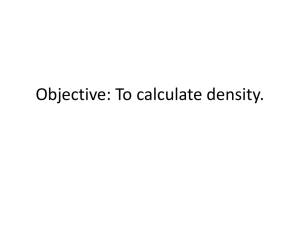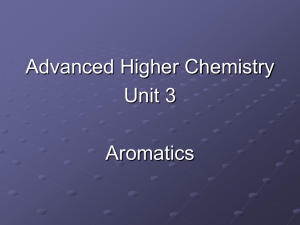Benzene Guideline
advertisement
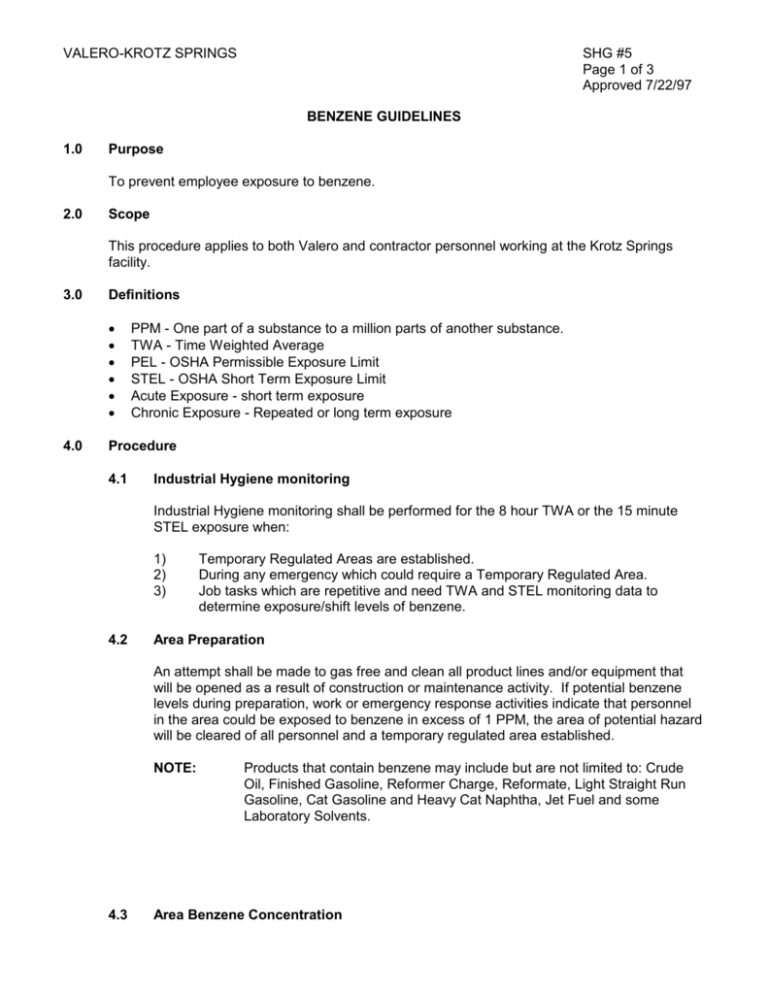
VALERO-KROTZ SPRINGS SHG #5 Page 1 of 3 Approved 7/22/97 BENZENE GUIDELINES 1.0 Purpose To prevent employee exposure to benzene. 2.0 Scope This procedure applies to both Valero and contractor personnel working at the Krotz Springs facility. 3.0 Definitions 4.0 PPM - One part of a substance to a million parts of another substance. TWA - Time Weighted Average PEL - OSHA Permissible Exposure Limit STEL - OSHA Short Term Exposure Limit Acute Exposure - short term exposure Chronic Exposure - Repeated or long term exposure Procedure 4.1 Industrial Hygiene monitoring Industrial Hygiene monitoring shall be performed for the 8 hour TWA or the 15 minute STEL exposure when: 1) 2) 3) 4.2 Temporary Regulated Areas are established. During any emergency which could require a Temporary Regulated Area. Job tasks which are repetitive and need TWA and STEL monitoring data to determine exposure/shift levels of benzene. Area Preparation An attempt shall be made to gas free and clean all product lines and/or equipment that will be opened as a result of construction or maintenance activity. If potential benzene levels during preparation, work or emergency response activities indicate that personnel in the area could be exposed to benzene in excess of 1 PPM, the area of potential hazard will be cleared of all personnel and a temporary regulated area established. NOTE: 4.3 Products that contain benzene may include but are not limited to: Crude Oil, Finished Gasoline, Reformer Charge, Reformate, Light Straight Run Gasoline, Cat Gasoline and Heavy Cat Naphtha, Jet Fuel and some Laboratory Solvents. Area Benzene Concentration VALERO-KROTZ SPRINGS SHG #5 Page 2 of 3 Approved 7/22/97 Any area or equipment to be opened that contains or may contain benzene shall be surveyed for benzene concentration. An area representative shall initiate a benzene concentration survey using a Draeger CMS unit or the Photovac Snapshot. Multiple readings shall be obtained to determine the actual size of area needing to be barricaded and the level of respiratory protection required. 4.4 4.5 Regulated Area 4.4.1 Temporary Regulated Areas will be established wherever the airborne concentration of benzene can reasonably be expected to exceed the OSHA permissible exposure limits, either the 8-hour time weighted average exposure of 1 PPM or the short-term exposure limit of 5 PPM for 15 minutes. 4.4.2 Regulated Areas will be established where the concentrations of benzene on a continuous basis exceeds the OSHA permissible exposure limits, either the 8-hour time weighted average exposure of 1 PPM or the short-term exposure limit of 5 PPM for 15 minutes. Barricades Any Regulated Area, temporary or permanent, will be barricaded at least 25’ in all directions and signs posted reading: DANGER BENZENE CANCER HAZARD AUTHORIZED PERSONNEL ONLY RESPIRATOR REQUIRED 4.6 5.0 Respirators Requirements: 4.6.1 For unknown concentrations of benzene, a positive pressure hose line (fresh air) or self contained breathing apparatus will be used. 4.6.2 For benzene concentrations below 50 PPM and equal to or more than 10 PPM, a full-face respirator with organic vapor cartridges will be used. 4.6.3 For benzene concentrations below 10 PPM and equal to or more than 0.5 PPM, a ½ mask respirator with organic vapor cartridges will be used. Medical Surveillance Program 5.1 Employee Benzene Exposure Testing After Potential Overexposure Biological testing will be done if a work activity or emergency event creates conditions that could have resulted in exposure of personnel in excess of the OSHA permissible limit. 5.1.1 Personnel Testing - If benzene levels measured indicate a potential that the personnel in the area of the measurement could have been exposed to benzene in excess of 1 PPM as an 8-hour time weighted average (TWA) VALERO-KROTZ SPRINGS SHG #5 Page 3 of 3 Approved 7/22/97 or 5 PPM as a fifteen minute average STEL (i.e., the short term exposure limit) without proper respiratory protection, the potentially affected personnel will report to the Krotz Springs safety office and be tested for the presence of urinary phenol according to the following conditions: The sample will be collected no sooner than two hours after the initial exposure. The specimen should be collected before the end of the work shift if possible or the individual(s) involved asked to stay until 2 hours have elapsed to provide the sample. If the individual cannot provide a sample at the end of the shift, they will be asked to provide a sample within 24 hours. If the individual is scheduled to report to work the following day, the sample will be collected prior to the start of that day’s work activities. Samples collected will be analyzed for urinary phenol within 72 hours at an approved test laboratory. If the urinary phenol test is below 75-mg phenol/l of urine, no further testing is required. If the urinary phenol test is 75 mg/l or more, the individual will be further tested to obtain a complete blood count as per OSHA 1910.1028 guidelines, at monthly intervals, for three months following the emergency exposure. A written opinion from the company provided physician/medical service shall be given the individual and to Valero within five work days of receipt of these results but in no case later than fifteen days after the examination. 5.1.2 Job Assignment - When a referral to a Hematologist/Internist is made under the Medical Surveillance Program, the employee shall be removed from the areas where exposures may exceed the Action Level until such time as the physician’s determination is made whether the employee shall be returned to his usual job or whether the employee should be removed permanently. 5.1.3 Medical Records - Any employee or authorized representative of that employee, requesting medical records, shall be provided with the medical records and information requested.
